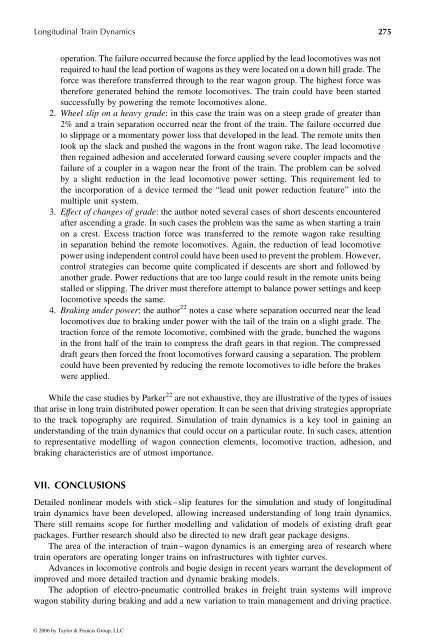Hi-Res PDF - CRCnetBASE
Hi-Res PDF - CRCnetBASE
Hi-Res PDF - CRCnetBASE
Create successful ePaper yourself
Turn your PDF publications into a flip-book with our unique Google optimized e-Paper software.
Longitudinal Train Dynamics 275<br />
operation. Thefailure occurred because the forceapplied by the lead locomotives was not<br />
required to haul the lead portion of wagons as they were located on adown hill grade.The<br />
force was therefore transferred through to the rear wagon group. The highest force was<br />
therefore generated behind the remote locomotives. The train could have been started<br />
successfully by powering the remote locomotives alone.<br />
2. Wheel slip on aheavy grade: inthis case the train was on asteep grade of greater than<br />
2% and atrain separation occurred near the front of the train. The failure occurred due<br />
to slippage or amomentary power loss that developed in the lead. The remote units then<br />
took up the slack and pushed the wagons in the front wagon rake. The lead locomotive<br />
then regained adhesion and accelerated forward causing severe coupler impacts and the<br />
failure of acoupler in awagon near the front of the train. The problem can be solved<br />
by aslight reduction in the lead locomotive power setting. This requirement led to<br />
the incorporation of adevice termed the “lead unit power reduction feature” into the<br />
multiple unit system.<br />
3. Effect of changes ofgrade: the author noted several cases of short descents encountered<br />
after ascending agrade. In such cases the problem was the same as when starting atrain<br />
on acrest. Excess traction force was transferred to the remote wagon rake resulting<br />
in separation behind the remote locomotives. Again, the reduction of lead locomotive<br />
power usingindependent control could have been used to prevent the problem. However,<br />
control strategies can become quite complicated if descents are short and followed by<br />
another grade. Power reductions that are too large could result in the remote units being<br />
stalled or slipping. Thedriver must therefore attempt to balance power settings and keep<br />
locomotive speeds the same.<br />
4. Braking under power: the author 22 notes acase where separation occurred near the lead<br />
locomotives due to braking under power with the tail of the train on aslight grade. The<br />
traction force ofthe remote locomotive, combined with the grade, bunched the wagons<br />
in the front half of the train to compress the draft gears in that region. The compressed<br />
draft gears then forced the front locomotives forward causing aseparation. The problem<br />
could have been prevented by reducing the remote locomotives to idle before the brakes<br />
were applied.<br />
While the case studies by Parker 22 are not exhaustive, they are illustrative of the typesofissues<br />
that arise in long train distributed poweroperation. It can be seen that driving strategies appropriate<br />
to the track topography are required. Simulation of train dynamics is akey tool in gaining an<br />
understanding of the train dynamics that could occur on aparticular route. In such cases, attention<br />
to representative modelling ofwagon connection elements, locomotive traction, adhesion, and<br />
braking characteristics are of utmost importance.<br />
VII. CONCLUSIONS<br />
Detailed nonlinear models with stick–slip features for the simulation and study oflongitudinal<br />
train dynamics have been developed, allowing increased understanding of long train dynamics.<br />
There still remains scope for further modelling and validation of models of existing draft gear<br />
packages. Further research should also be directed to new draft gear package designs.<br />
The area of the interaction of train–wagon dynamics is an emerging area of research where<br />
train operators are operating longer trains on infrastructures with tighter curves.<br />
Advances in locomotive controls and bogie design in recent years warrant the development of<br />
improved and more detailed traction and dynamic braking models.<br />
The adoption of electro-pneumatic controlled brakes infreight train systems will improve<br />
wagon stability during braking and add anew variation to train management and driving practice.<br />
© 2006 by Taylor & Francis Group, LLC









